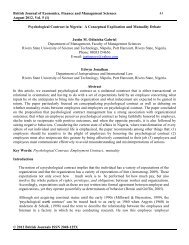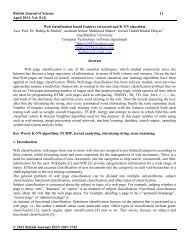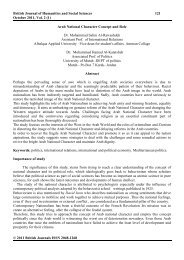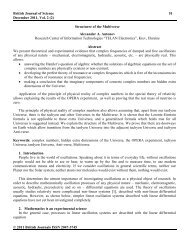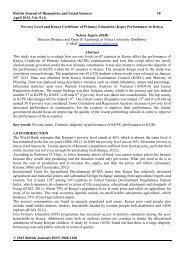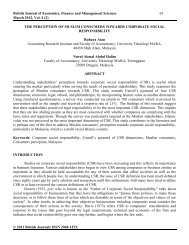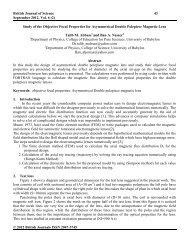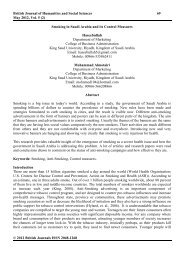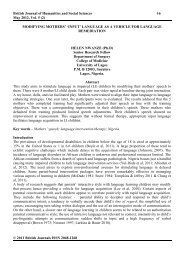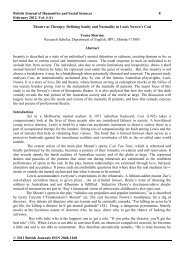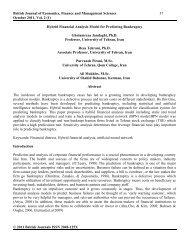A Comparative Study of the Mechanical Properties of Fresh and ...
A Comparative Study of the Mechanical Properties of Fresh and ...
A Comparative Study of the Mechanical Properties of Fresh and ...
Create successful ePaper yourself
Turn your PDF publications into a flip-book with our unique Google optimized e-Paper software.
British Journal <strong>of</strong> Science 73<br />
November 2011, Vol. 2 (1)<br />
A <strong>Comparative</strong> <strong>Study</strong> <strong>of</strong> <strong>the</strong> <strong>Mechanical</strong> <strong>Properties</strong> <strong>of</strong> <strong>Fresh</strong> <strong>and</strong> Dried Bamboo<br />
Lawrence Gyansah<br />
Rutgers University, The State University <strong>of</strong> New Jersey, USA<br />
Department <strong>of</strong> <strong>Mechanical</strong> Engineering<br />
Record Service<br />
University <strong>of</strong> Liberia<br />
T.J.R Faulkner College <strong>of</strong> Science <strong>and</strong> Technology, Division <strong>of</strong> Engineering<br />
Abstract<br />
This paper investigates <strong>the</strong> development <strong>of</strong> <strong>the</strong> mechanical properties for both <strong>the</strong> fresh <strong>and</strong> dried<br />
bamboo samples (Bambusa Vulgaris). Crushing strength experiment was performed using<br />
Uniaxial Compression Machine. The data is plotted as crushing stress versus height, load versus<br />
time <strong>of</strong> failure, crushing stress versus moisture content <strong>and</strong> crushing stress versus thickness.<br />
Microstructures were also analyzed for both specimens. Results show that, huge crack measured<br />
to be 8 mm along <strong>the</strong> longitudinal axis was observed for dried bamboo <strong>and</strong> that <strong>of</strong> <strong>the</strong> fresh was<br />
4.3 mm. The measured angle <strong>of</strong> orientation <strong>of</strong> <strong>the</strong> cr<br />
43 2 44 6 . Results fur<strong>the</strong>r<br />
show that failure stress <strong>of</strong> a fresh bamboo is higher than that <strong>of</strong> dried bamboo <strong>and</strong> microstructure<br />
<strong>of</strong> fresh bamboo shows much deformation than that <strong>of</strong> <strong>the</strong> dried bamboo. Deformation <strong>of</strong> fresh<br />
bamboo mimics that <strong>of</strong> a twisted bundle <strong>of</strong> sticks whiles that <strong>of</strong> <strong>the</strong> dried bamboo does not. The<br />
fresh bamboo <strong>and</strong> <strong>the</strong> dried bamboo experienced several crack initiations though <strong>the</strong> dried<br />
bamboo did not have any cup zone. The moisture content for both bamboos increases with<br />
increase in <strong>the</strong> crushing stresses but <strong>the</strong> dried bamboo showed smaller crushing stresses with<br />
respect to <strong>the</strong> moisture content. The percentage differences in <strong>the</strong> moisture content for both fresh<br />
<strong>and</strong> dried bamboos were between 86.5 % <strong>and</strong> 86.93 % at a height <strong>of</strong> 250 mm <strong>and</strong> 90 mm.<br />
Keywords: Cup Zone, Cone Zone, Cylindrical Zone, M-graph, S-graph, Bambusa Vulgaris,<br />
Crushing Strength, Loading Failure, Moisture Content, <strong>Fresh</strong> Bamboo, Dried Bamboo<br />
1. Introduction<br />
Liberia as a country is endowed with<br />
considerable forest reserve but faces<br />
<strong>the</strong> threat <strong>of</strong> losing its forest cover in<br />
about 23 years <strong>and</strong> becoming a desert if<br />
<strong>the</strong> current alarming rate <strong>of</strong> deforestation<br />
<strong>of</strong> 65000 ha annually continues without<br />
support from all stakeholders. In efforts<br />
to solve this menace, agriculturalist <strong>and</strong><br />
botanists have resulted to <strong>the</strong> use <strong>of</strong><br />
regenerative <strong>and</strong> early maturing plant<br />
species such as bamboo. Bamboo is a<br />
grass <strong>and</strong> not a product derived from<br />
forestry (Yus<strong>of</strong>f et al., 1992). As a<br />
result, bamboo is considered a highly<br />
renewable <strong>and</strong> sustainable product that<br />
can save our ever-dwindling forests. In<br />
view <strong>of</strong> this, most construction firms in<br />
Liberia have switched to <strong>the</strong> use <strong>of</strong><br />
© 2011 British Journals ISSN 2047-3745
British Journal <strong>of</strong> Science 74<br />
November 2011, Vol. 2 (1)<br />
bamboo. They use bamboo for <strong>the</strong><br />
construction <strong>of</strong> formwork <strong>and</strong> most<br />
times as a prop or supporting systems in<br />
building construction. In addition,<br />
bamboo is used for <strong>the</strong> manufacture <strong>of</strong><br />
wooden flooring panels, support in<br />
traditional housing <strong>and</strong> structural<br />
reinforcement (Oteng. et al, 2003).<br />
Despite <strong>the</strong> aforementioned applications<br />
<strong>of</strong> bamboo, accidents do happen with <strong>the</strong><br />
use <strong>of</strong> this material as well as its general<br />
constructional usage. It is <strong>the</strong>refore very<br />
imperative to have a comparative study<br />
on <strong>the</strong> failure or breaking stress <strong>of</strong> both<br />
<strong>the</strong> fresh <strong>and</strong> dried bamboo (i.e. <strong>the</strong><br />
stress at which bamboo under loading<br />
will fail disastrously), to investigate <strong>and</strong><br />
educate <strong>the</strong> public on <strong>the</strong> crushing<br />
strength <strong>of</strong> both fresh <strong>and</strong> dried bamboo,<br />
to have a comparative study on <strong>the</strong> crack<br />
initiation sites <strong>and</strong> crack orientations for<br />
both <strong>the</strong> fresh <strong>and</strong> dried bamboo <strong>and</strong><br />
established a baseline microstructure<br />
analysis for both specimens.<br />
Fig.2.1. Bamboo (Bambusa Vulgaris) Plantation<br />
2. Background History<br />
Bambusa Vulgaris specie has green<br />
bright motley with yellow stems. The<br />
distance between <strong>the</strong> nodes is 27 to 45<br />
cm <strong>and</strong> <strong>the</strong> wall is relatively thin.<br />
Sometimes this specie is subspontaneous<br />
in <strong>the</strong> region <strong>of</strong> low altitude<br />
<strong>and</strong> where rainfalls are higher, than 1000<br />
mm (Grosser <strong>and</strong> Liese, 1971). It is<br />
found in all <strong>the</strong> tropical countries over<br />
<strong>the</strong> world <strong>and</strong> widely cultivated since its<br />
shoots are edible though it is not<br />
possible now to determine <strong>the</strong> country <strong>of</strong><br />
origin. The ecological requirement <strong>of</strong><br />
this species is extreme in moist forest<br />
© 2011 British Journals ISSN 2047-3745
British Journal <strong>of</strong> Science 59<br />
November 2011, Vol. 2 (1)<br />
zones as well as in wooded savannah<br />
zones. It can also grow well at altitudes<br />
between sea level <strong>and</strong> 1000 m. With<br />
regard to soil, Bambusa Vulgaris does<br />
not tolerate too compact clay loam soil<br />
Bamboo is very important selfregenerating<br />
<strong>and</strong> renewable non-timber<br />
natural resource. It grows very quickly<br />
once establish, is self-sustaining <strong>and</strong><br />
does not need replanting after<br />
harvesting. Compared to <strong>the</strong> cost <strong>of</strong><br />
growing <strong>and</strong> tending some vegetables or<br />
fruit trees, bamboo growing can be<br />
relatively inexpensive (Jaspreet, 2009).<br />
Some bamboo species can grow up to 1<br />
meter per day. During <strong>the</strong> first 2-3 years<br />
<strong>of</strong> growth, o<strong>the</strong>r crops can be grown in<br />
<strong>the</strong> grove to help recover <strong>the</strong> initial<br />
capital. Bamboo has a natural habitat in<br />
most countries <strong>of</strong> Africa. Essentially a<br />
grass, some species grow up to 18.288 m<br />
in height <strong>and</strong> one foot in diameter, while<br />
some <strong>of</strong> <strong>the</strong>m form a middle tier in <strong>the</strong><br />
mixed natural forests. As a general<br />
feature, <strong>the</strong> root system <strong>of</strong> bamboo <strong>and</strong><br />
its closely placed stumps create<br />
numerous little barriers <strong>and</strong> holds <strong>the</strong> top<br />
soil firmly, arresting erosion <strong>and</strong> flash<br />
floods. This allows water to soak into <strong>the</strong><br />
soil from being washed away, creating<br />
ideal soil conditions for vigorous plant<br />
life. It is estimated that resources wide<br />
world <strong>of</strong> bamboo is made up <strong>of</strong> seventyfive<br />
(75) genera <strong>and</strong> one thous<strong>and</strong>, two<br />
hundred <strong>and</strong> fifty (1,250) species <strong>of</strong><br />
which fifteen (15) genera are found in<br />
Africa. The trade estimate <strong>of</strong> world<br />
<strong>and</strong> salty soils Feng et al (2002). These<br />
three bamboo species encountered in<br />
Africa, specifically in Liberia have stems<br />
attaining a height <strong>of</strong> 6 to 15 m with basal<br />
diameter <strong>of</strong> 5 to 10 cm (CTFT, 1962).<br />
bamboo is also estimated around 7<br />
billion United States Dollars (USD), <strong>of</strong><br />
this amount, Africa Share is very<br />
negligible (ABS, 2005). ABS means<br />
America Bamboo Society. One<br />
important aspect <strong>of</strong> bamboo is that, it is<br />
a commodity at many different level <strong>of</strong><br />
economy. It is a subsistence crop <strong>and</strong><br />
source <strong>of</strong> income to people with very<br />
limited opportunities to earn cash<br />
income in Liberia. At least from <strong>the</strong><br />
China experience, bamboo is a versatile<br />
raw material for wide range <strong>of</strong> small <strong>and</strong><br />
medium-scale enterprises, <strong>and</strong> so serves<br />
as a basis for employment <strong>and</strong> income<br />
generation for quite a number <strong>of</strong> people.<br />
The taxonomic identification <strong>of</strong><br />
bamboos in Liberia has been confusing<br />
<strong>and</strong> difficult. There is little accurate data<br />
or information on <strong>the</strong> different species <strong>of</strong><br />
bamboo growing in Liberia. However,<br />
<strong>the</strong> Forestry Research Institute <strong>of</strong> Liberia<br />
estimate that <strong>the</strong>re are up to seven<br />
species identified <strong>of</strong> which Bambusa<br />
Vulgaris is <strong>the</strong> predominant species <strong>and</strong><br />
form about 95 % <strong>of</strong> all <strong>the</strong> total species.<br />
It is also estimated that <strong>the</strong> current total<br />
hectares <strong>of</strong> Bamboo in Liberia is<br />
between 250,000 <strong>and</strong> 300,000 hectares,<br />
according to <strong>the</strong> Forestry Research<br />
Institute <strong>of</strong> Liberia in 2003.<br />
These seven species mentioned are Abd.Latif (1990);<br />
Bambusa Arundinacea.<br />
Bambusa Bambos.<br />
Bambusa Multiplex.<br />
Bambusa Pervariabilis.<br />
Bambusa Vulgaris (green variety).<br />
© 2011 British Journals ISSN 2047-3745
British Journal <strong>of</strong> Science 2<br />
November 2011, Vol. 2 (1)<br />
<br />
<br />
Bambusa Vulgaris Var. Vitata (yellow–green variety).<br />
Dendrocalamus Strictus.<br />
3. Materials <strong>and</strong> Methods<br />
3.1 Materials<br />
The type <strong>of</strong> Bamboo specie used for this research is Bambusa Vulgaris (fresh <strong>and</strong> dried<br />
bamboo about five years old). The fresh Bambusa Vulgaris comprises about 47.30 %<br />
moisture whiles <strong>the</strong> dried bamboo contains 6.63 % moisture by weight. Bambusa Vulgaris<br />
was obtained from University <strong>of</strong> Liberia, Liberia. The experiments were carried out in <strong>the</strong><br />
Geological Engineering Laboratory <strong>of</strong> <strong>the</strong> University <strong>of</strong> Liberia, Liberia in 2011.<br />
3.2 Sample Preparation<br />
The fresh <strong>and</strong> dried Bambusa Vulgaris as received from <strong>the</strong> forest fields were free from<br />
insect infestation. The specimens were polished with P 1200, P 120 <strong>and</strong> P 60 abrasive paper.<br />
Compressed air was blown on <strong>the</strong> surface <strong>of</strong> <strong>the</strong> specimen to remove dirt particles. The<br />
specimens were carefully cut such that, <strong>the</strong> node lies at <strong>the</strong> centre <strong>of</strong> <strong>the</strong> height. The<br />
maximum specimen height for <strong>the</strong> experiment was 250 mm for both specimens. It was <strong>the</strong>n<br />
reduced with an interval <strong>of</strong> 40 mm to <strong>the</strong> lowest height <strong>of</strong> 90 mm.<br />
3.3 Specimen Design<br />
Fig.3.1 <strong>and</strong> Fig 3.2. show Bambusa Vulgaris specimens. Specimens were cut into <strong>the</strong><br />
requisite shape by <strong>the</strong> use <strong>of</strong> <strong>the</strong> cross-cut saw machine. S ’ 90<br />
250 mm with 40 mm interval. External diameters are between 50 to 62 mm <strong>and</strong> thicknesses<br />
are between 5 to 10 mm for both fresh <strong>and</strong> dried bamboos.<br />
Fig.3.1. Dried Bamboo Specimen<br />
Fig.3.2. <strong>Fresh</strong> Bamboo Specimen<br />
4 Experimental<br />
© 2011 British Journals ISSN 2047-3745
British Journal <strong>of</strong> Science 2<br />
November 2011, Vol. 2 (1)<br />
Crushing experiment, moisture content experiment <strong>and</strong> microstructural analysis were conducted<br />
on both fresh <strong>and</strong> dried specimens.<br />
4.1 Crushing Strength Experiment<br />
The crushing strength experiment was<br />
performed with <strong>the</strong> used <strong>of</strong> <strong>the</strong> uniaxial<br />
compressive machine (Maximum force:<br />
1500 kN) a 25 C<br />
Four hundred specimens were used to carry<br />
out <strong>the</strong> experiment. The various specimens<br />
were cleaned <strong>and</strong> polished with abrasive<br />
paper. The dried bamboo specimens were<br />
dried in <strong>the</strong> sun at a temperature between<br />
28-31 C for 30 days. After which <strong>the</strong><br />
diameter <strong>and</strong> <strong>the</strong> thickness <strong>of</strong> <strong>the</strong> fresh <strong>and</strong><br />
dried specimens were measured with a<br />
vernier caliper. The maximum height <strong>of</strong> <strong>the</strong><br />
specimens was 250 mm but was stepped<br />
down by 40 mm interval hence obtaining<br />
heights <strong>of</strong> 210 mm, 170 mm, 130 mm <strong>and</strong><br />
90 mm. Each specimen with <strong>the</strong> specific<br />
height was placed inside <strong>the</strong> uniaxial<br />
v T ’<br />
was properly closed <strong>and</strong> <strong>the</strong> controlling unit<br />
was triggered to start compression <strong>and</strong> <strong>the</strong><br />
specimen is tested to failure. The machine<br />
automatically cut <strong>of</strong>f when <strong>the</strong> specimen<br />
was crushed <strong>and</strong> <strong>the</strong> load <strong>of</strong> failure is<br />
displayed on <strong>the</strong> monitor. The monitor<br />
displays a graph <strong>of</strong> load <strong>of</strong> failure (crushing<br />
strength) against time <strong>of</strong> failure. Fig. 4.1 <strong>and</strong><br />
4.2 show <strong>the</strong> fresh <strong>and</strong> dried Bamboo<br />
specimens under crushing test.<br />
<strong>Fresh</strong> Bamboo<br />
Specimen<br />
Fig. 4.1 Bamboo Specimen under Crushing Test (<strong>Fresh</strong><br />
Specimen)<br />
© 2011 British Journals ISSN 2047-3745
British Journal <strong>of</strong> Science 2<br />
November 2011, Vol. 2 (1)<br />
Dried Bamboo<br />
Specimen<br />
Fig. 4.2 Bamboo Specimen under Crushing Test (Dried Specimen)<br />
4.2 Microstructure Experiment<br />
Microstructures were analyzed. Before <strong>the</strong> crushing test, two pieces <strong>of</strong> fresh <strong>and</strong> dried bamboo <strong>of</strong><br />
dimension 30 mm 30 mm were cut out. The specimen were grinded with abrasive paper <strong>of</strong><br />
grades <strong>of</strong> 1200 P, 120 P <strong>and</strong> 60 P especially on <strong>the</strong> face where <strong>the</strong> investigations were to be<br />
carried out. The specimens were firmly secured on a plasticizer by a press machine. Electronic<br />
microscope was used to take <strong>the</strong> microstructure. Magnification <strong>of</strong> 10x was used in this<br />
experiment. After <strong>the</strong> specimens were tested in a uniaxial compression machine, microstructures<br />
were also taken.<br />
4.3 Moisture Content Experiment<br />
This moisture content experiment was<br />
performed to know <strong>the</strong> amount <strong>of</strong> water<br />
present in <strong>the</strong> fresh Bamboo <strong>and</strong> dried<br />
specimens <strong>and</strong> it effect on <strong>the</strong> crushing<br />
strength <strong>of</strong> <strong>the</strong> bamboo. Since <strong>the</strong> bamboo<br />
specimens were all from one culm, four<br />
specimens <strong>of</strong> <strong>the</strong> fresh <strong>and</strong> dried bamboo<br />
after crushing were weighed <strong>and</strong> recorded.<br />
After that <strong>the</strong> specimens were oven dried for<br />
a day, weigh <strong>and</strong> recorded.<br />
According to (Head, 1992), <strong>the</strong> moisture<br />
content formula is given by:<br />
Moisture Content (MC %) = (4.3)<br />
Where,<br />
(MC) is <strong>the</strong> moisture content <strong>of</strong> bamboo specimen.<br />
(w 1 ) is <strong>the</strong> mass <strong>of</strong> crushed specimen<br />
© 2011 British Journals ISSN 2047-3745
British Journal <strong>of</strong> Science 2<br />
November 2011, Vol. 2 (1)<br />
(W 2 ) is <strong>the</strong> mass <strong>of</strong> crushed sample after 24 hours <strong>of</strong> oven drying at 110 o C.<br />
5 Results <strong>and</strong> Discussion<br />
Experimental results on <strong>the</strong> crushing<br />
strength <strong>and</strong> moisture content are shown in<br />
table 1 <strong>and</strong> 2. Five specimens <strong>of</strong> <strong>the</strong> same<br />
height were crushed <strong>and</strong> for <strong>the</strong> sake <strong>of</strong><br />
accuracy <strong>of</strong> results, average loads <strong>of</strong> failure<br />
<strong>of</strong> specimens were calculated. For instance,<br />
for a height <strong>of</strong> 250 mm, five specimens <strong>of</strong><br />
height 250 mm for both <strong>the</strong> fresh <strong>and</strong> dried<br />
bamboo were crushed <strong>and</strong> average load <strong>of</strong><br />
failure was calculated. A similar trend was<br />
followed for <strong>the</strong> heights <strong>of</strong> specimen <strong>of</strong> 210<br />
mm, 170 mm, 130 mm <strong>and</strong> 90 mm. From<br />
table 1, <strong>the</strong> crushing stresses for a height <strong>of</strong><br />
250 mm, 210 mm, 170 mm, 130 mm, <strong>and</strong> 90<br />
mm were 51.3093 MPa, 71.1447 MPa,<br />
74.5867 MPa, 79.5905 MPa, <strong>and</strong> 85.2036<br />
MPa respectively. It could be seen that as<br />
<strong>the</strong> height increases <strong>the</strong> crushing strength<br />
decreases. Therefore, <strong>the</strong> height has<br />
significant influence on <strong>the</strong> crushing<br />
strength <strong>of</strong> <strong>the</strong> fresh bamboo. The load <strong>of</strong><br />
failure also has tentative influence on <strong>the</strong><br />
height <strong>of</strong> <strong>the</strong> bamboo. Results from <strong>the</strong><br />
moisture content experiment <strong>of</strong> <strong>the</strong> fresh<br />
bamboo did not show any significant trend<br />
this may be due to <strong>the</strong> varying lignin water<br />
absorption capacity <strong>and</strong> <strong>the</strong> effect <strong>of</strong> ageing<br />
<strong>of</strong> <strong>the</strong> fresh bamboo.<br />
From table 2, it could be seen that <strong>the</strong> load<br />
<strong>of</strong> failure increases with decrease in height<br />
<strong>of</strong> <strong>the</strong> bamboo. This actually follows <strong>the</strong><br />
same criteria as <strong>the</strong> fresh bamboo. But<br />
comparing <strong>the</strong> load <strong>of</strong> failure <strong>of</strong> <strong>the</strong> fresh to<br />
<strong>the</strong> dried bamboo at <strong>the</strong> same height, it is<br />
clear that <strong>the</strong> fresh bamboo has <strong>the</strong> highest.<br />
This may be due to <strong>the</strong> high moisture<br />
content in <strong>the</strong> fresh bamboo. This made <strong>the</strong><br />
fresh bamboo tougher than <strong>the</strong> dried<br />
bamboo. The stresses in <strong>the</strong> fresh bamboo<br />
were also higher than that <strong>of</strong> <strong>the</strong> dried<br />
bamboo. The moisture content in <strong>the</strong> dried<br />
bamboo decreases with increase in height,<br />
but <strong>the</strong> fresh bamboo did not show any<br />
significant trend. Also in table 2 it could be<br />
seen that as <strong>the</strong> moisture content increases<br />
<strong>the</strong> load <strong>of</strong> failure increases.<br />
© 2011 British Journals ISSN 2047-3745
British Journal <strong>of</strong> Science 2<br />
November 2011, Vol. 2 (1)<br />
A<br />
B<br />
Cup Zone<br />
Cracks<br />
C<br />
Cone Zone<br />
Node<br />
D<br />
Cylindrical<br />
Zone<br />
Fig. 1 <strong>Fresh</strong> Bamboo subjected to Uniaxial Compressive Loading<br />
Fig.1 shows <strong>the</strong> results <strong>of</strong> fresh bamboo<br />
specimen subjected to uniaxial compressive<br />
load. The appearance <strong>of</strong> <strong>the</strong> fractured<br />
sections <strong>of</strong> <strong>the</strong> fresh bamboo gives<br />
information about <strong>the</strong> magnitude <strong>of</strong> <strong>the</strong><br />
stress that caused <strong>the</strong> cracks. It was observed<br />
that several cracks initiated from <strong>the</strong> cup<br />
zone (AB). At point A, <strong>the</strong> smashed surface<br />
was caused by <strong>the</strong> opening <strong>and</strong> closing <strong>of</strong><br />
<strong>the</strong> crack during its development. The cracks<br />
in <strong>the</strong> cup zone started when <strong>the</strong><br />
compressive load applied exceeded <strong>the</strong><br />
strength <strong>of</strong> <strong>the</strong> weakest grain on a cross<br />
section. Continued operation caused <strong>the</strong><br />
crack to grow persistently as <strong>the</strong> strength <strong>of</strong><br />
say adjacent grains was exceeded by <strong>the</strong><br />
high stress at <strong>the</strong> crack tip. If <strong>the</strong><br />
compressive load is at high value, <strong>the</strong><br />
strength at a number <strong>of</strong> grains around <strong>the</strong><br />
edge <strong>of</strong> <strong>the</strong> smashed surface was probably<br />
exceeded. This will cause cracks to start <strong>and</strong><br />
spread till <strong>the</strong>y unite with one ano<strong>the</strong>r.<br />
These cracks progressed toward <strong>the</strong> cone<br />
zone (BC). Within <strong>the</strong> cone zone, <strong>the</strong> cracks<br />
grow concurrently toward <strong>the</strong> longitudinal<br />
axis. The measured angle <strong>of</strong> orientation <strong>of</strong><br />
<strong>the</strong> cracks with respect to <strong>the</strong> longitudinal<br />
44 6 T<br />
<strong>the</strong> cone zone was considerably greater than<br />
<strong>the</strong> endurance limit <strong>of</strong> <strong>the</strong> material at that<br />
state. Therefore, very large cracks were seen<br />
<strong>and</strong> failure <strong>of</strong> <strong>the</strong> material would be caused<br />
by only a small compressive loadings<br />
applied on <strong>the</strong> material. The cylindrical zone<br />
(CD) did not experience many crack<br />
initiations. The cracks propagated parallel to<br />
<strong>the</strong> longitudinal axis <strong>of</strong> <strong>the</strong> material. These<br />
cracks grown until it got to <strong>the</strong> node. The<br />
highest crack measured was 4.3 mm along<br />
<strong>the</strong> longitudinal axis. The node <strong>of</strong> <strong>the</strong><br />
bamboo is designed naturally to resist<br />
cracks. Higher compressive loadings were<br />
needed to break <strong>the</strong> resistive forces at <strong>the</strong><br />
node. It was <strong>the</strong>refore observed that <strong>the</strong><br />
cracks at <strong>the</strong> cylindrical zone did not<br />
propagate beyond <strong>the</strong> node before failure <strong>of</strong><br />
<strong>the</strong> entire material.<br />
© 2011 British Journals ISSN 2047-3745
British Journal <strong>of</strong> Science 2<br />
November 2011, Vol. 2 (1)<br />
D<br />
A<br />
Cone Zone<br />
B<br />
Crack<br />
E<br />
Cylindrical Zone<br />
C<br />
Fig. 2 Dried Bamboo subjected to Uniaxial Compressive Loading<br />
Fig.2 shows <strong>the</strong> results <strong>of</strong> dried bamboo specimen subjected to uniaxial compressive load. As<br />
compared to Fig.1, Fig.2 did not show know cup zone. Huge crack measured to be 8 mm along<br />
<strong>the</strong> longitudinal axis from point D to E was observed. This crack propagated from point D to E.<br />
The fixture <strong>of</strong> <strong>the</strong> crack is actually along <strong>the</strong> longitudinal axis. It is also clear that <strong>the</strong> shape <strong>of</strong><br />
point AB mimicked that <strong>of</strong> <strong>the</strong> cone. Therefore given <strong>the</strong> name <strong>the</strong> cone zone (AB). Within <strong>the</strong><br />
cone zone, <strong>the</strong> cracks grew concurrently toward <strong>the</strong> longitudinal axis. The measured angle <strong>of</strong><br />
orientation <strong>of</strong> <strong>the</strong> cracks with respect to <strong>the</strong> longitudinal axis was approximately 43.2 T<br />
stress in <strong>the</strong> cone zone was considerably greater than <strong>the</strong> endurance limit <strong>of</strong> <strong>the</strong> material at that<br />
state. Therefore, very large cracks were seen <strong>and</strong> failure <strong>of</strong> <strong>the</strong> material would be caused by only<br />
a small compressive loadings applied on <strong>the</strong> material. The cylindrical zone (BC) did not<br />
experience many crack initiations as also observed in cylindrical zone (CD) <strong>of</strong> Fig.1. The cracks<br />
also in cylindrical zone (BC) propagated parallel to <strong>the</strong> longitudinal axis <strong>of</strong> <strong>the</strong> material. These<br />
cracks grown until it got to <strong>the</strong> node. <strong>Comparative</strong>ly, higher compressive loadings were needed<br />
to break <strong>the</strong> resistive forces at <strong>the</strong> node. It was <strong>the</strong>refore also observed that <strong>the</strong> cracks at <strong>the</strong><br />
cylindrical zone did not propagate beyond <strong>the</strong> node before failure <strong>of</strong> <strong>the</strong> entire material.<br />
© 2011 British Journals ISSN 2047-3745
British Journal <strong>of</strong> Science 2<br />
November 2011, Vol. 2 (1)<br />
Table. 1 Detailed Results <strong>of</strong> Crushing Strength <strong>and</strong> Moisture Content <strong>of</strong> <strong>the</strong> <strong>Fresh</strong> Bamboo<br />
Specime<br />
n Type<br />
Heig<br />
ht<br />
(mm)<br />
Externa<br />
l<br />
Diamete<br />
r D o<br />
(mm)<br />
Internal<br />
Diamete<br />
r Di<br />
(mm)<br />
Area<br />
(mm 2 )<br />
© 2011 British Journals ISSN 2047-3745<br />
Load<br />
<strong>of</strong><br />
Failure<br />
(KN)<br />
Crushin<br />
g Stress<br />
(MPa)<br />
Thickness<br />
T(mm)<br />
Mass<br />
(g)<br />
Mass<br />
at 110<br />
˚C<br />
FRESH 250.0 60.0 40.0<br />
1570.796<br />
24.75<br />
58.3 37.1149 10.0 504.0 404<br />
3<br />
FRESH 250.0 55.0 43.0 923.6282 62.2 67.3431 6.0 430.0 330 30.30<br />
FRESH 250.0 46.0 30.0 955.0442 70.0 73.2950 8.0 281.3 181.3 55.16<br />
FRESH 250.0 58.0 44.0<br />
1121.548<br />
30.39<br />
59.5 53.0516 7.0 429.1 329.1<br />
6<br />
FRESH 250.0 56.0 36.0<br />
1445.132<br />
40.00<br />
37.2 25.7416 10.0 350.0 250.0<br />
6<br />
Average 250.0 55.0 39.0<br />
1203.229<br />
398.9<br />
36.12<br />
57.4 51.3093 8.2<br />
298.9<br />
9<br />
FRESH 210.0 45.0 31.0 835.6636 74.6 89.2704 7.0 286.9 186.9 53.50<br />
FRESH 210.0 49.0 29.0<br />
1225.221<br />
38.61<br />
51.8 42.2781 10.0 359.0 259.0<br />
1<br />
FRESH 210.0 56.0 44.0 942.4778 64.5 68.4791 6.0 280.0 180 55.56<br />
FRESH 210.0 58.0 42.0<br />
1256.637<br />
36.76<br />
83.0 66.0493 8.0 372.0 272<br />
1<br />
FRESH 210.0 54.0 44.0 769.6902 69.0 89.6465 5.0 411.0 311 32.15<br />
Average 210.0 52.4 38.4 1005.938 68.6 71.1447 7.2 341.78 241.78 43.32<br />
FRESH 170.0 60.0 40.0<br />
1570.796<br />
52.35<br />
74.2 28.9662 10.0 291.0 191<br />
3<br />
FRESH 170.0 42.0 30.0 678.5840 66.5 97.9982 6.0 365.0 265 37.74<br />
FRESH 170.0 46.0 32.0 857.6548 69.8 75.5549 7.0 260.0 160 62.5<br />
FRESH 170.0 53.6 35.6<br />
1261.035<br />
59.17<br />
73.8 58.5233 9.0 269.0 169<br />
3<br />
FRESH 170.0 40.0 26.0 725.7079 81.2 111.8907 7.0 302.0 202 49.50<br />
Average 170.0 48.3 32.7 1018.8 73.1 74.5867 7.8 297.4 197.4 52.25<br />
FRESH 130.0 45.0 29.0 929.9114 76.0 81.7282 8.0 349.0 249 40.16<br />
FRESH 130.0 49.0 37.0 810.5309 73.7 90.9281 6.0 327.0 227 44.05<br />
FRESH 130.0 50.0 30.0<br />
1256.637<br />
32.47<br />
80.5 64.0599 10.0 408.0 308<br />
1<br />
FRESH 130.0 40.0 26.0 725.7079 69.5 95.7686 7.0 360.0 260 38.46<br />
FRESH 130.0 56.0 38.0<br />
1328.893<br />
56.18<br />
87.0 65.4680 9.0 278.0 178<br />
7<br />
Average 130.0 48 32.0<br />
1010.336<br />
42.26<br />
77.3 79.5905 8 344.4 244.4<br />
2<br />
MC<br />
%
British Journal <strong>of</strong> Science 3<br />
November 2011, Vol. 2 (1)<br />
FRESH 90.0 60.0 42.0<br />
1441.991<br />
81.30<br />
64.7 44.8685 9.0 223.0 123<br />
0<br />
FRESH 90.0 43.0 27.0 879.6459 77.5 88.1036 6.0 259.0 159 62.89<br />
FRESH 90.0 46.0 30.0 955.0442 83.6 87.5352 7.0 115.1 115.1 86.805<br />
FRESH 90.0 40.0 24.0 804.2477 79.6 98.9745 8.0 333.0 233 42.91<br />
FRESH 90.0 42.0 28.0 769.6902 82.0 106.5364 7.0 358.0 258 38.76<br />
Average 90.0 46.2 30.2 970.1238 77.48 85.2036 7.4 257.6 157.6 62.53<br />
Table. 2 Detailed Results <strong>of</strong> Crushing Strength <strong>and</strong> Moisture Content <strong>of</strong> <strong>the</strong> Dried Bamboo<br />
Specime<br />
n Type<br />
Height<br />
(mm)<br />
Externa<br />
l<br />
Diamete<br />
r D o<br />
(mm)<br />
Internal<br />
Diameter<br />
Di (mm)<br />
DRIED 250.0 43.0 27.0<br />
DRIED<br />
DRIED<br />
DRIED<br />
DRIED<br />
250.0 55.0 35.0<br />
250.0 47.0 35.0<br />
250.0 50.0 32.0<br />
250.0 58.0 44.0<br />
Average 250.0 50.6 34.6<br />
DRIED<br />
DRIED<br />
DRIED<br />
DRIED<br />
DRIED<br />
210.0 45.0 29.0<br />
210.0 60.0 40.0<br />
210.0 57.0 45.0<br />
210.0 55.0 45.0<br />
210.0 49.0 35.0<br />
Average 210.0 53.2 38.8<br />
DRIED<br />
170.0 60.0 40.0<br />
Area<br />
(mm 2 )<br />
879.64<br />
59<br />
1413.7<br />
167<br />
772.83<br />
18<br />
1159.2<br />
477<br />
1121.5<br />
486<br />
1069.3<br />
981<br />
929.91<br />
14<br />
1570.7<br />
963<br />
961.32<br />
74<br />
785.39<br />
82<br />
923.62<br />
82<br />
1034.2<br />
123<br />
1570.7<br />
963<br />
Loa<br />
d <strong>of</strong><br />
Fail<br />
ure<br />
(KN<br />
)<br />
32.8<br />
60.3<br />
36.5<br />
48.2<br />
47.3<br />
45.0<br />
2<br />
65.2<br />
74.6<br />
48.5<br />
53.0<br />
66.0<br />
61.4<br />
6<br />
51.9<br />
Crushi<br />
ng<br />
Stress<br />
(MPa)<br />
37.287<br />
7<br />
42.653<br />
5<br />
47.228<br />
9<br />
41.578<br />
7<br />
42.173<br />
8<br />
42.184<br />
5<br />
70.114<br />
2<br />
47.491<br />
8<br />
50.451<br />
1<br />
67.481<br />
7<br />
71.457<br />
3<br />
61.399<br />
2<br />
33.040<br />
6<br />
Thickne<br />
ss<br />
T(mm)<br />
Mass<br />
(g)<br />
8.0 362.0 347<br />
10.0 212.0 202<br />
6.0 245.0 235<br />
9.0 301.0 286<br />
7.0 260.0 247<br />
8 276<br />
C<br />
8.0 199.0 186.9<br />
10.0 211.0 200.0<br />
6.0 217.0 204.0<br />
5.0 150.0 140.0<br />
7.0 280.0 265.0<br />
MC %<br />
4.32<br />
4.95<br />
4.69<br />
5.24<br />
5.26<br />
263.4 4.89<br />
6.42<br />
5.50<br />
6.37<br />
7.14<br />
5.66<br />
7.2 213.6 199.18 6.22<br />
10.0 175.0 163<br />
7.36<br />
© 2011 British Journals ISSN 2047-3745
British Journal <strong>of</strong> Science 4<br />
November 2011, Vol. 2 (1)<br />
DRIED<br />
170.0 57.0 39.0<br />
DRIED<br />
170.0 58.0 42.0<br />
DRIED<br />
170.0 52.0 40.0<br />
DRIED<br />
170.0 42.0 28.0<br />
Average 170.0 53.8 37.8<br />
DRIED<br />
130.0 50.0 34.0<br />
DRIED<br />
130.0 56.0 36.0<br />
DRIED<br />
130.0 40.0 28.0<br />
DRIED<br />
130.0 60.0 42.0<br />
DRIED<br />
130.0 43.0 29.0<br />
Average 130.0 49.8 33.8<br />
DRIED<br />
90.0 55.0 43.0<br />
DRIED<br />
90.0 50.0 40.0<br />
DRIED<br />
90.0 58.0 42.0<br />
DRIED<br />
90.0 45.0 35.0<br />
DRIED<br />
90.0 48.0 34.0<br />
Average 90.0 51.2 38.8<br />
1357.1<br />
680<br />
1256.6<br />
371<br />
867.07<br />
96<br />
769.69<br />
02<br />
1164.2<br />
74<br />
1055.5<br />
751<br />
1445.1<br />
326<br />
640.88<br />
49<br />
1441.9<br />
910<br />
791.68<br />
13<br />
1075.0<br />
53<br />
923.62<br />
82<br />
706.85<br />
83<br />
1256.6<br />
371<br />
628.31<br />
85<br />
901.63<br />
71<br />
883.41<br />
584<br />
42.5<br />
76.5<br />
80.0<br />
88.1<br />
67.8<br />
52.7<br />
75.0<br />
56.0<br />
70.5<br />
80.0<br />
66.8<br />
4<br />
49.9<br />
63.0<br />
68.0<br />
59.8<br />
73.2<br />
62.7<br />
8<br />
31.315<br />
2<br />
60.876<br />
8<br />
92.263<br />
7<br />
114.46<br />
16<br />
66.391<br />
6<br />
49.925<br />
4<br />
51.898<br />
4<br />
87.379<br />
2<br />
48.890<br />
7<br />
101.05<br />
08<br />
67.828<br />
9<br />
54.026<br />
1<br />
89.126<br />
8<br />
54.112<br />
7<br />
95.174<br />
7<br />
81.185<br />
7<br />
74.725<br />
2<br />
9.0 138.0 130.0<br />
8.0 144.8 136.0<br />
6.0 248.0 233.0<br />
7.0 169.0 158.0<br />
8<br />
174.9<br />
6<br />
8.0 146.0 136.0<br />
10.0 162.0 152.0<br />
6.0 182.0 170.0<br />
9.0 190.0 175<br />
7.0 171.0 161.0<br />
6.15<br />
6.62<br />
6.44<br />
6.96<br />
164 6.71<br />
7.35<br />
6.58<br />
7.06<br />
8.57<br />
6.21<br />
8 170.2 158.8 7.15<br />
6.0 195.0 180<br />
10.0 123.0 113.0<br />
8.0 145.0 133<br />
5.0 217.5 200.0<br />
7.0 169.0 159.0<br />
8.33<br />
8.84<br />
9.02<br />
8.50<br />
6.23<br />
7.2 169.9 157 8.18<br />
© 2011 British Journals ISSN 2047-3745
British Journal <strong>of</strong> Science 5<br />
November 2011, Vol. 2 (1)<br />
Fig. 3 A Graph <strong>of</strong> Crushing Stress versus Height<br />
From Fig. 3, shows a scatter diagram,<br />
it is clear that <strong>the</strong> crushing stress <strong>of</strong><br />
fresh bamboo decreases as <strong>the</strong> height<br />
<strong>of</strong> <strong>the</strong> bamboo increases. At a height <strong>of</strong><br />
250 mm <strong>the</strong> crushing stress is 51.3<br />
MPa whiles at a height <strong>of</strong> 90 mm <strong>the</strong><br />
crushing stress is 85.2 MPa. It is also<br />
clear in Fig. 3 that <strong>the</strong> crushing<br />
strength <strong>of</strong> <strong>the</strong> fresh bamboo is larger<br />
than that <strong>of</strong> <strong>the</strong> dried bamboo. It can be<br />
concluded that <strong>the</strong> fresh bamboo is<br />
tougher than <strong>the</strong> dried bamboo at <strong>the</strong><br />
same height. The two graphs also<br />
followed <strong>the</strong> same pattern (i.e. M-<br />
graph).<br />
© 2011 British Journals ISSN 2047-3745
British Journal <strong>of</strong> Science 2<br />
November 2011, Vol. 2 (1)<br />
Fig. 4 A Graph <strong>of</strong> Crushing Stress versus Thickness<br />
Fig.4 shows a scatter diagram where<br />
crushing stress is plotted against <strong>the</strong><br />
thickness for both <strong>the</strong> fresh <strong>and</strong> dried<br />
bamboo. The fresh bamboo did not show a<br />
significant trend for a meaningful deduction<br />
to be made. A decrease in <strong>the</strong> thickness did<br />
not give say an increase in <strong>the</strong> crushing<br />
stress or vice versa. At a thickness <strong>of</strong> 8.2<br />
mm a crushing 51.3 kN/m 2 is achieved. The<br />
graph also shows clearly that <strong>the</strong> dried<br />
bamboo is smaller in thickness than <strong>the</strong><br />
fresh bamboo. This means that <strong>the</strong> fresh<br />
bamboo has a higher crushing stress or load<br />
<strong>of</strong> failure. It is <strong>the</strong>refore obvious that <strong>the</strong><br />
significance <strong>of</strong> crushing stress does not<br />
depend on only <strong>the</strong> thickness but also <strong>the</strong><br />
amount <strong>of</strong> moisture in <strong>the</strong> bamboo.<br />
© 2011 British Journals ISSN 2047-3745
British Journal <strong>of</strong> Science 2<br />
November 2011, Vol. 2 (1)<br />
Fig. 5 Crushing stress versus Moisture Content<br />
From Fig. 5, it is clear that moisture content<br />
for both bamboo increases with increase in<br />
<strong>the</strong> crushing stresses but <strong>the</strong> dried bamboo<br />
showed smaller crushing stresses with<br />
respect to <strong>the</strong> moisture content. The graph <strong>of</strong><br />
<strong>the</strong> fresh bamboo mimics that <strong>of</strong> an S-graph<br />
whiles that <strong>of</strong> <strong>the</strong> dried bamboo was linear.<br />
The fresh bamboo actually experienced a<br />
linear graph from point A to B <strong>and</strong> <strong>the</strong>n<br />
changes in direction till point C. The change<br />
in direction at point B may be due to <strong>the</strong><br />
varying moisture content within <strong>the</strong> bamboo.<br />
The percentage difference in <strong>the</strong> moisture<br />
content for both fresh <strong>and</strong> dried bamboo was<br />
between 86.5 % <strong>and</strong> 86.93 % at a height <strong>of</strong><br />
250 mm <strong>and</strong> 90 mm.<br />
© 2011 British Journals ISSN 2047-3745
British Journal <strong>of</strong> Science 2<br />
November 2011, Vol. 2 (1)<br />
DARK<br />
CLOUDY<br />
GRAINS<br />
Direction <strong>of</strong> Loading<br />
Fig.6. Microstructure <strong>of</strong> <strong>Fresh</strong> Bamboo before Compressive Loading<br />
Direction <strong>of</strong> Loading<br />
WHITE<br />
CLOUDY<br />
GRAINS<br />
Fig.7. Microstructure <strong>of</strong> Dried Bamboo before Compressive Loading<br />
Fig.6 shows <strong>the</strong> microstructure <strong>of</strong> fresh<br />
bamboo before test. The direction <strong>of</strong> loading<br />
© 2011 British Journals ISSN 2047-3745<br />
<strong>of</strong> <strong>the</strong> grain is shown with <strong>the</strong> parallel arrow<br />
lines. From Fig.6, it was observed that <strong>the</strong>
British Journal <strong>of</strong> Science 2<br />
November 2011, Vol. 2 (1)<br />
grains are aligned parallel but look dark<br />
cloudy <strong>and</strong> not very bright due <strong>the</strong> relatively<br />
high moisture content (i.e. high water<br />
presence). Fig. 7 shows white cloudy grains<br />
which are also aligned parallel <strong>and</strong> look<br />
bright indicating low moisture content.<br />
A<br />
Fig. 8 Microstructure <strong>of</strong> <strong>Fresh</strong> Bamboo after Compressive Loading<br />
© 2011 British Journals ISSN 2047-3745
British Journal <strong>of</strong> Science 3<br />
November 2011, Vol. 2 (1)<br />
Fig. 9 Microstructure <strong>of</strong> Dried Bamboo after Crushing<br />
From Fig.8, <strong>the</strong> grains <strong>of</strong> <strong>the</strong> fresh Bamboo<br />
after crushing shows a contour-like pattern<br />
due to <strong>the</strong> extent <strong>of</strong> deformation caused by<br />
<strong>the</strong> subjected load on <strong>the</strong> bamboo specimen.<br />
The deformations in <strong>the</strong>se cases were severe<br />
with few brownish-dark areas representing<br />
<strong>the</strong> stress concentration areas (i.e. severe<br />
deformation). Several cracks were seen <strong>and</strong><br />
<strong>the</strong>se are illustrated by <strong>the</strong> dark arrows.<br />
Cracks initiations <strong>of</strong> <strong>the</strong> various<br />
deformations in <strong>the</strong> microstructure are also<br />
shown by <strong>the</strong> dark arrows. Deformation<br />
mimics that <strong>of</strong> a twisted bundle <strong>of</strong> sticks.<br />
Explaining <strong>the</strong> fact that <strong>the</strong> grains <strong>of</strong> <strong>the</strong><br />
deformed fresh bamboo are packed <strong>and</strong><br />
cracks initiations could have started from<br />
any <strong>of</strong> <strong>the</strong> highly stressed areas shown in <strong>the</strong><br />
microstructure. At arrow A, crack could<br />
have started from that point <strong>and</strong> propagated<br />
through <strong>the</strong> material till failure <strong>of</strong> <strong>the</strong> entire<br />
material. It is <strong>the</strong>refore obvious that cracks<br />
initiations in <strong>the</strong> microstructure could have<br />
stated anywhere within <strong>the</strong> material<br />
provided those areas are stress concentrated<br />
points. In Fig.9, deformations do not mimic<br />
a twisted bundle <strong>of</strong> sticks. Crack could have<br />
actually started from say point B <strong>and</strong><br />
propagated in <strong>the</strong> material. In was also<br />
observed that <strong>the</strong> crack grows faster in <strong>the</strong><br />
dried bamboo than <strong>the</strong> fresh bamboo. This<br />
may be due to <strong>the</strong> high moisture content in<br />
<strong>the</strong> fresh bamboo.<br />
The crack could have also started from <strong>the</strong><br />
slightly deformed area. Crack initiations are<br />
© 2011 British Journals ISSN 2047-3745
British Journal <strong>of</strong> Science 59<br />
November 2011, Vol. 2 (1)<br />
also shown by <strong>the</strong> dark arrows. The stress<br />
6. Conclusions<br />
concentration area is slightly deformed.<br />
<br />
<br />
The moisture content for both bamboo increases with increase in <strong>the</strong> crushing stresses but<br />
<strong>the</strong> dried bamboo showed smaller crushing stresses with respect to <strong>the</strong> moisture content.<br />
The moisture content has significant effect on <strong>the</strong> crushing strength.<br />
For a dried bamboo <strong>of</strong> heights 250mm, 210mm, 170mm, 130mm, <strong>and</strong> 90mm, a crushing<br />
strength <strong>of</strong> 42.1845 MPa, 61.3992 MPa, 66.3916 MPa, 67.8289 MPa, 74.7252 MPa<br />
respectively were obtained whiles that <strong>of</strong> <strong>the</strong> fresh bamboo were 51.3093 MPa, 71.1447<br />
MPa, 74.5867 MPa, 85.2036 MPa, 79.5905 MPa.<br />
<br />
<br />
The significance <strong>of</strong> crushing stress on both <strong>the</strong> fresh <strong>and</strong> dried bamboo does not depend<br />
on only <strong>the</strong> thickness but also <strong>the</strong> amount <strong>of</strong> moisture in <strong>the</strong> bamboo.<br />
Deformation <strong>of</strong> fresh bamboo mimics that <strong>of</strong> a twisted bundle <strong>of</strong> sticks whiles that <strong>of</strong> <strong>the</strong><br />
dried bamboo does not.<br />
<br />
<br />
<br />
The moisture content graph for <strong>the</strong> fresh bamboo mimics that <strong>of</strong> an S-graph whiles that <strong>of</strong><br />
<strong>the</strong> dried bamboo was linear.<br />
The microstructure <strong>of</strong> <strong>the</strong> fresh bamboos show clear indication <strong>of</strong> severe grain<br />
deformation whiles that <strong>of</strong> <strong>the</strong> dried bamboos were slightly deformed.<br />
The microstructure for <strong>the</strong> fresh bamboo shows a contour-like pattern with few brownishdark<br />
areas whiles that <strong>of</strong> <strong>the</strong> dried bamboo shows white cloudy grains which are also<br />
aligned parallel due to low moisture content.<br />
<br />
<br />
The fresh bamboo <strong>and</strong> <strong>the</strong> dried bamboo experienced several crack initiations although<br />
<strong>the</strong> dried bamboo did not have any cup zone.<br />
At <strong>the</strong> same height, <strong>the</strong> fresh bamboo is tougher than <strong>the</strong> dried bamboo. This means<br />
that <strong>the</strong> failure stress <strong>of</strong> a fresh bamboo is higher than that <strong>of</strong> a dried bamboo.<br />
<br />
The percentage differences in <strong>the</strong> moisture content for both fresh <strong>and</strong> dried bamboo were<br />
between 86.5 % <strong>and</strong> 86.93 % at a height <strong>of</strong> 250 mm <strong>and</strong> 90 mm.<br />
© 2011 British Journals ISSN 2047-3745
British Journal <strong>of</strong> Science 48<br />
November 2011, Vol. 2 (1)<br />
<br />
<br />
<br />
The dried bamboo is smaller in thickness than <strong>the</strong> fresh bamboo. This means that <strong>the</strong> fresh bamboo<br />
has a higher crushing stress or load <strong>of</strong> failure.<br />
Huge crack measured to be 8 mm along <strong>the</strong> longitudinal axis <strong>of</strong> <strong>the</strong> dried bamboo was observed<br />
whiles that <strong>of</strong> <strong>the</strong> fresh bamboo was 4.3 mm. Crack grows faster in <strong>the</strong> dried bamboo than <strong>the</strong> fresh<br />
bamboo.<br />
The measured angle <strong>of</strong> orientation <strong>of</strong> <strong>the</strong> cracks with respect to <strong>the</strong> longitudinal axis was<br />
43 2 es that <strong>of</strong> <strong>the</strong> fresh bamboo was 44.6 .<br />
7. Recommendation<br />
<br />
Bamboo can be used as formwork or supporting systems in building constructions <strong>and</strong> mining<br />
companies, since it has good crushing strength. Especially <strong>the</strong> fresh bamboo. Bamboos must be<br />
employed in <strong>the</strong> manufacture <strong>of</strong> wooden flooring panels, support in traditional housing <strong>and</strong> structural<br />
reinforcements in Africa <strong>and</strong> <strong>the</strong> world over. Bamboo should be properly preserved to increase its life<br />
span.<br />
8. Acknowledgement<br />
The Author wish to acknowledge <strong>the</strong> support <strong>of</strong> RTI International <strong>and</strong> <strong>the</strong> USAID-funded EHELD<br />
project in enabling <strong>the</strong> production <strong>of</strong> this research. The Author is also thankful to <strong>the</strong> management <strong>of</strong><br />
<strong>the</strong> geological laboratory <strong>of</strong> <strong>the</strong> University <strong>of</strong> Liberia, Liberia.<br />
9. References<br />
1. Head, K.A., 1992. Manual <strong>of</strong> Soil Laboratory Testing, Soil Classification <strong>and</strong> Compaction Tests,<br />
Second Edition, Pentech Press, London, pp: 68-76.<br />
2 O A , 2003 “Sustainable Development <strong>of</strong> Bamboo Resources in Ghana” R<br />
Conference, Forest Research Institute <strong>of</strong> Ghana, pp 4 – 8.<br />
3. H I R 2009 “ An Assessment <strong>of</strong> <strong>the</strong> Validity <strong>of</strong> Claims for “Bamboo” Fibers”<br />
AATCC International Conference in Myrtle Beach, S.C, USA. pp. 33-36.<br />
4. W D J S S J (1987), “Bamboo <strong>of</strong> China”, T P , P , O ” 167<br />
5. L , S C P , J M (1981), “<strong>Mechanical</strong> <strong>Properties</strong> <strong>of</strong> Bamboo, N C ”<br />
Volume 14, issue 4, Elsevier Science Ltd. pp. 319 – 322.<br />
6. A (1998), “F T M G S B :<br />
Composites Part B: Engineering Volume 28, Issues 1-2, Elsevier Science Ltd, pp. 13-20.<br />
© 2011 British Journals ISSN 2047-3745
British Journal <strong>of</strong> Science 49<br />
November 2011, Vol. 2 (1)<br />
7. Hammett et a (2001), “N -wood Fiber as an alternative to Wood Fiber in China Pulp <strong>and</strong> Paper<br />
I ”. Volume 55, Issue 2, Holzforschung, pp. 219–224.<br />
8. J J A (2000), “B B : A h<strong>and</strong>book. Intermediate Technology Publications<br />
limited, 103-105 Southampton Row, London WC1B 4HH, UK, pp.65.<br />
9. Y (1992), “U z B P P ”, Proceedings <strong>of</strong> Seminar<br />
Toward <strong>the</strong> Management, Conversation, Marketing <strong>and</strong> Utilization <strong>of</strong> Bamboo. Bombay, India,<br />
pp.196 – 205.<br />
10. X , L (2004), “P , C M P B ”, MSc. Project<br />
Report, Chinese Academy <strong>of</strong> Forestry, China, pp. 27.<br />
11. Gere, J. M. (2004), <strong>Mechanical</strong> <strong>of</strong> Materials, B. Stenquist Publishers, United States <strong>of</strong> America,<br />
pp. 4.<br />
12. A L (1990), “E <strong>the</strong> Anatomical <strong>Properties</strong> on <strong>the</strong> Physical <strong>and</strong> <strong>Mechanical</strong> <strong>Properties</strong><br />
B B ” 159 – 170.<br />
13. D (1962), C T q F T , “N T P ” 105 – 119.<br />
14. D C , (1992), “D L ” MSc Project Report, Louisiana State University,<br />
Lousiana, pp. 33 – 61.<br />
15. F (2002), “A C C F C T<br />
S B ” 3<br />
16. G L (1971), “A A B S R erence to Vascular<br />
B ” 473 – 483.<br />
17. H (2001), “N -wood Fiber as an alternative to Wood Fiber in China Wood <strong>and</strong><br />
P I ” 219 – 224.<br />
18. J G (2009), “B H P ”, R C , U K ,<br />
pp. 3 – 9.<br />
19. K , N K K (1990), “M B C E ”,<br />
Proceeding 40 th Japanese Timber Conference. Tokyo, Japan, pp. 27 – 29.<br />
20. Wan -T z , W A (2005), “N A B L B S<br />
L ”, p. 2 – 3.<br />
© 2011 British Journals ISSN 2047-3745




